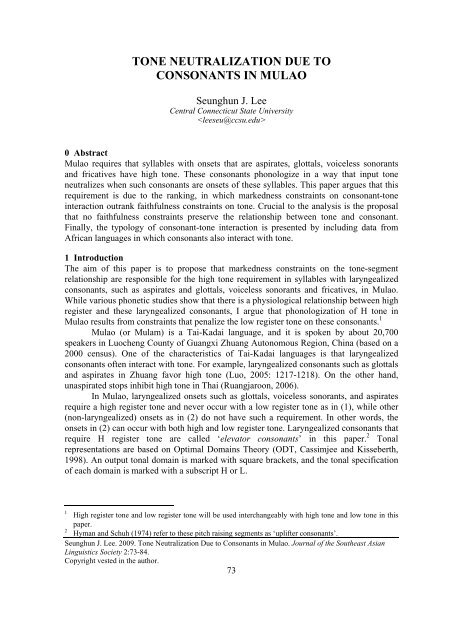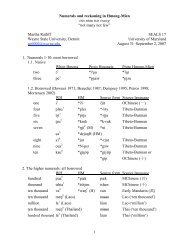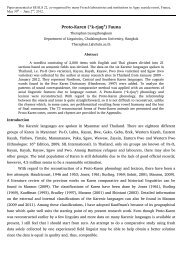proto-southwestern-tai revised: a new reconstruction - seals 22
proto-southwestern-tai revised: a new reconstruction - seals 22
proto-southwestern-tai revised: a new reconstruction - seals 22
Create successful ePaper yourself
Turn your PDF publications into a flip-book with our unique Google optimized e-Paper software.
TONE NEUTRALIZATION DUE TO<br />
CONSONANTS IN MULAO<br />
Seunghun J. Lee<br />
Central Connecticut State University<br />
<br />
0 Abstract<br />
Mulao requires that syllables with onsets that are aspirates, glottals, voiceless sonorants<br />
and fricatives have high tone. These consonants phonologize in a way that input tone<br />
neutralizes when such consonants are onsets of these syllables. This paper argues that this<br />
requirement is due to the ranking, in which markedness constraints on consonant-tone<br />
interaction outrank faithfulness constraints on tone. Crucial to the analysis is the proposal<br />
that no faithfulness constraints preserve the relationship between tone and consonant.<br />
Finally, the typology of consonant-tone interaction is presented by including data from<br />
African languages in which consonants also interact with tone.<br />
1 Introduction<br />
The aim of this paper is to propose that markedness constraints on the tone-segment<br />
relationship are responsible for the high tone requirement in syllables with laryngealized<br />
consonants, such as aspirates and glottals, voiceless sonorants and fricatives, in Mulao.<br />
While various phonetic studies show that there is a physiological relationship between high<br />
register and these laryngealized consonants, I argue that phonologization of H tone in<br />
Mulao results from constraints that penalize the low register tone on these consonants. 1<br />
Mulao (or Mulam) is a Tai-Kadai language, and it is spoken by about 20,700<br />
speakers in Luocheng County of Guangxi Zhuang Autonomous Region, China (based on a<br />
2000 census). One of the characteristics of Tai-Kadai languages is that laryngealized<br />
consonants often interact with tone. For example, laryngealized consonants such as glottals<br />
and aspirates in Zhuang favor high tone (Luo, 2005: 1217-1218). On the other hand,<br />
unaspirated stops inhibit high tone in Thai (Ruangjaroon, 2006).<br />
In Mulao, laryngealized onsets such as glottals, voiceless sonorants, and aspirates<br />
require a high register tone and never occur with a low register tone as in (1), while other<br />
(non-laryngealized) onsets as in (2) do not have such a requirement. In other words, the<br />
onsets in (2) can occur with both high and low register tone. Laryngealized consonants that<br />
require H register tone are called ‘elevator consonants’ in this paper. 2 Tonal<br />
representations are based on Optimal Domains Theory (ODT, Cassimjee and Kisseberth,<br />
1998). An output tonal domain is marked with square brackets, and the tonal specification<br />
of each domain is marked with a subscript H or L.<br />
1<br />
High register tone and low register tone will be used interchangeably with high tone and low tone in this<br />
paper.<br />
2<br />
Hyman and Schuh (1974) refer to these pitch raising segments as ‘uplifter consonants’.<br />
Seunghun J. Lee. 2009. Tone Neutralization Due to Consonants in Mulao. Journal of the Southeast Asian<br />
Linguistics Society 2:73-84.<br />
Copyright vested in the author.<br />
73





